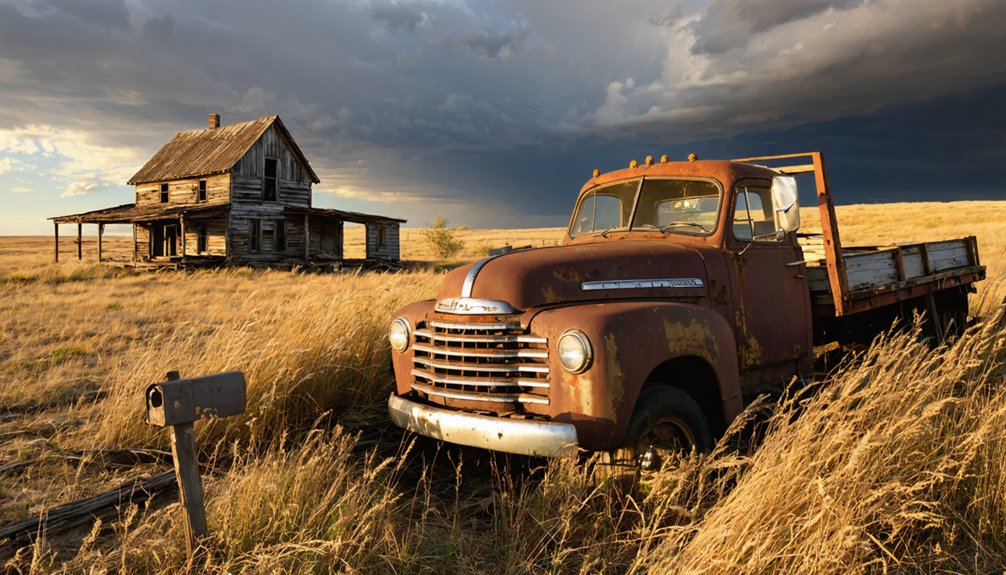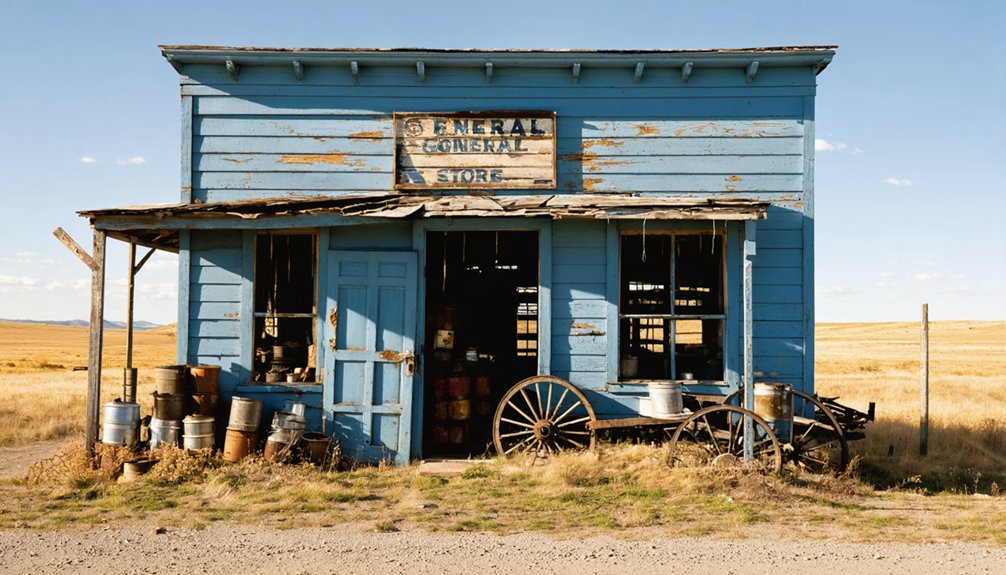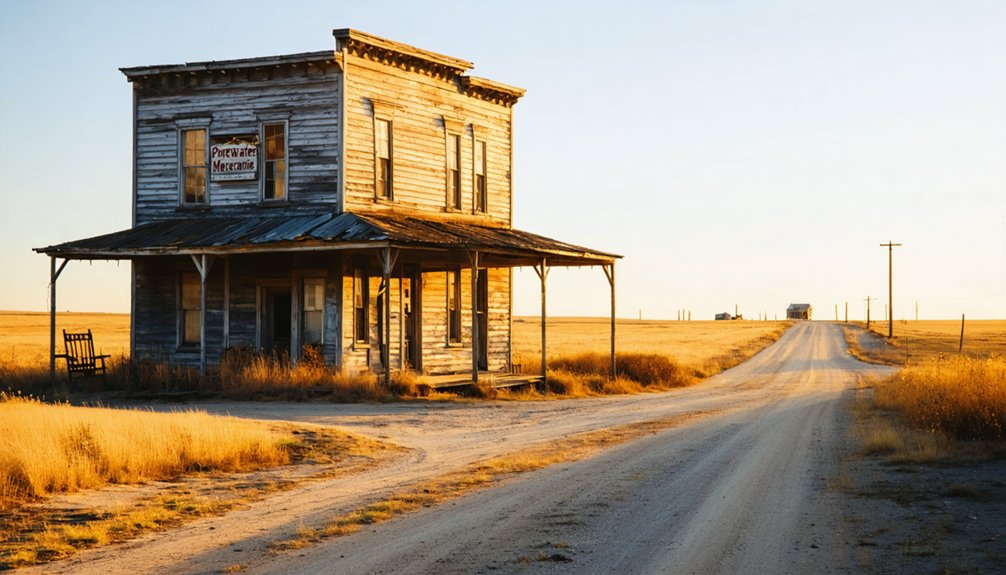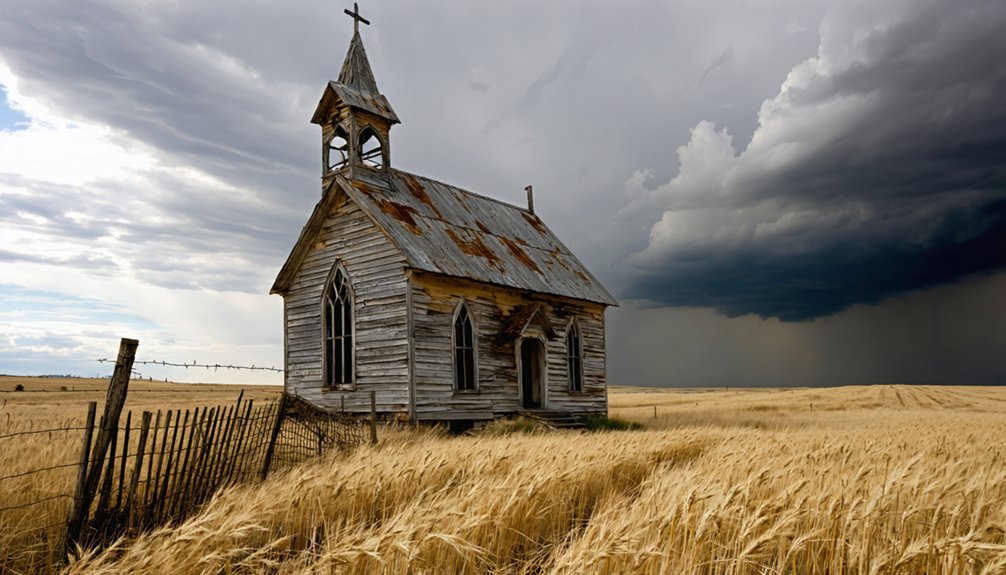You’ll find Purewater’s ghost town remains in South Dakota’s Black Hills, where it flourished during the late 1800s gold rush era. The Homestake Mining Company dominated the area, extracting 43 million troy ounces of gold over 125 years through advanced mining operations. Today, only two structures survive – the old church and parsonage – accessible via dirt roads. The town’s decline began with the 1952 sawmill closure, though its rich mining heritage holds countless untold stories.
Key Takeaways
- Purewater was a former mining town in South Dakota’s Black Hills region that thrived during the late 19th-century gold rush.
- The town’s economy centered around mining operations, lumber mills, and its role as a supply station for regional miners.
- Only two structures remain today: the old church and parsonage, accessible via dirt roads in deteriorating conditions.
- The town’s decline accelerated after the 1952 sawmill closure, frequent flooding, and the discontinuation of essential railroad service.
- Nature is reclaiming the ghost town site, with preservation efforts hampered by isolation and limited funding.
The Rise of a Mining Settlement
When gold was discovered in the Black Hills during the late 19th century, South Dakota’s landscape transformed rapidly into a hub of mining activity.
You would’ve witnessed thousands of prospectors flooding the region, establishing makeshift camps that quickly evolved into structured settlements. The implementation of mining policies shaped how these communities developed, with settlement regulations dictating everything from land claims to operational guidelines. Mining camps like Deadwood emerged as bustling centers of trade and commerce.
As the rush intensified, you’d have seen the emergence of essential infrastructure. Roads carved through the wilderness, while mills and processing facilities sprung up to support the growing mining operations. George Hearst’s group purchased a significant claim in the area for $70,000 in 1877.
The arrival of railroads further accelerated development, connecting these frontier settlements to the outside world. Companies like Homestake Mine drove this expansion, investing in technologies that made it profitable to extract even low-grade ore deposits.
Life in Early Purewater
Life in early Purewater mirrored the typical patterns of Black Hills mining settlements, with the community organizing itself around the rhythms of mine work and frontier survival.
You’d find social interactions centered on the few gathering spots – saloons, boarding houses, and makeshift churches. Community dynamics developed through necessity, with residents banding together to face harsh conditions and limited resources. Like other prairie towns that emerged during westward expansion, early settlers came seeking their dreams of prosperity.
Daily existence meant maneuvering through crowded living quarters, from basic tents to simple frame houses. Similar to towns like Ardmore, the settlement relied heavily on railroad transportation for supplies and trade.
Miners endured cramped spaces in makeshift shelters, sharing tight quarters whether in canvas tents or wooden structures.
You’d have dealt with rudimentary sanitation, wood-heated homes, and constant health risks from disease and mining accidents. While a doctor might’ve been scarce, neighbors often stepped in to help each other through illness and injury.
Schools, if present, operated from single rooms, and social clubs emerged as the population grew more stable.
Economic Foundations and Industry
You’ll find that Purewater’s economic bedrock rested firmly on its mining operations, which included extensive placer mining activities and the construction of essential infrastructure like sluice boxes and supply routes.
The town’s strategic location along newly constructed railroad lines enhanced its position as a regional trading hub, connecting it to larger markets in the Black Hills region. Similar to what happened at Camp Warren’s site, transportation networks played a crucial role in the town’s early development. Like the town of Mystic, Purewater served as a vital supply station where miners could restock their provisions.
Your understanding of Purewater’s economy wouldn’t be complete without noting how the railroad’s presence sparked the development of secondary industries, including lumber mills and merchant shops that served both the mining operations and the growing population.
Mining Operations and Infrastructure
The legendary Homestake Mine anchored South Dakota’s mining industry for 125 years, producing an astounding 43 million troy ounces of gold from its 370-mile network of tunnels that reached depths of 8,000 feet.
Mining technology evolved rapidly, from the initial 80-stamp mill in 1878 to advanced chlorination processes at facilities like the Golden Reward plant. By 1901, the mine replaced animal power with compressed air locomotives for more efficient underground transportation.
You’ll find evidence of extensive infrastructure that supported these massive operations. Homestake built its own railroad for transportation, while implementing sophisticated water management systems to handle environmental impact from acid drainage and sulfide waste.
The mining operations transformed the landscape with processing facilities, shaft systems, and treatment plants. Even after closure, this infrastructure found new life – the Homestake Mine’s shafts and facilities were converted into the Sanford Underground Research Facility.
Regional Trade Networks
Mining operations sparked wider economic networks throughout the Black Hills region, shaping local commerce and trade relationships.
However, with Purewater, South Dakota’s regional trade networks and economic foundations, there’s significant uncertainty in the historical record. You won’t find documented evidence of its trade routes or economic activity in available sources. Today, the area serves as a popular spot for recreational fishing activities.
Due to this lack of verified historical information:
- No confirmed trade partnerships or commercial relationships can be established
- The timing and extent of any economic decline remains unknown
- The town’s role in broader regional commerce networks isn’t documented
While many South Dakota ghost towns have well-documented histories of their economic rise and fall, Purewater’s specific commercial activities and trade connections remain a mystery.
Additional historical evidence would be needed to accurately describe its regional economic impact.
Daily Routines and Community Spirit
If you’d visited a South Dakota ghost town during its heyday, you’d have witnessed miners rising before dawn to begin their grueling shifts extracting precious metals from the earth.
You’d have seen the clockwork routine of workers trudging to the mines, while merchants opened their shops and children headed to the town’s schoolhouse.
When the workday ended, you’d have found the community gathering at local establishments or town halls, where residents strengthened their bonds through social events, shared meals, and celebrations that helped them cope with the harsh realities of mining life.
Daily Mining Life Rhythms
Deep beneath South Dakota’s rugged terrain, life followed precise rhythms as miners navigated their dangerous 8-hour shifts through complex tunnel systems reaching depths of 8,000 feet.
The underground challenges demanded unwavering focus, as you’d coordinate with your crew through each phase of the mining cycle. Miners relied on vital safety equipment and practices that included helmets, work lamps, and steel-toed shoes to maintain their remarkably low accident rates. Many workers came from the Homestake Mining Company which dominated the region’s mining operations by 1881.
- You’d start by drilling into solid rock with pneumatic tools, advancing about 10 feet daily while keeping thousands of steel bits sharp for continuous operation.
- At shift’s end, you’d retreat to safe zones for controlled blasting, part of the precise daily choreography that kept the mine’s heartbeat steady.
- Your crew would then extract the broken ore, loading one-ton cars while maintaining critical ventilation systems pumping 500,000 cubic feet of fresh air per minute.
This mining camaraderie forged unbreakable bonds, as shared dangers and daily rhythms united crews in their underground world.
Community Gatherings After Work
While specific records of Purewater’s social life remain scarce, you’d find that community gatherings formed the heart of daily routines in Black Hills mining towns after the day’s work ended. You might’ve joined your neighbors for church events, picnics, or dances, fostering community bonding that helped everyone endure the harsh rural environment.
These social traditions played a vital role in maintaining the town’s spirit, especially during economic hardships. In mining towns like Purewater, you’d discover that limited leisure options made these gatherings essential for maintaining connections.
Neighbors relied heavily on each other, sharing stories and preserving local customs. Despite resource constraints, these community-driven events created lasting bonds that defined the resilient character of Black Hills settlements.
The Beginning of the End

Although Purewater thrived during the Black Hills mining boom, the town’s decline began with the closure of its sawmill in 1952.
You’d have witnessed the rapid community decline as the mining operations became less profitable and the essential railroad service disappeared, cutting off critical supply routes.
The environmental impact and geographic challenges sealed Purewater’s fate:
- Frequent flooding damaged the town’s infrastructure and accelerated its abandonment
- The challenging landscape limited potential for agricultural diversification
- Mining operations left their mark on the surrounding terrain, tying the town’s destiny to resource extraction
Remnants and Ruins Today
Today, visitors to Purewater will find only two remaining structures standing as silent witnesses to the town’s former liveliness – the old church and its parsonage.
You’ll need to navigate dirt roads to reach these historic remnants, as modern development has bypassed this remote location. While remnant exploration attracts some adventurous spirits, the buildings’ deteriorating condition poses potential risks to visitors.
Unlike more tourist-oriented ghost towns like Cottonwood, Purewater’s ruins preservation faces significant challenges due to its isolation and lack of funding.
Remote and underfunded, Purewater’s historic structures face a bleaker fate than South Dakota’s more accessible ghost towns.
Nature slowly reclaims the site, and without community support or organized preservation efforts, these last pieces of history continue to decay.
The church and parsonage, though still standing, tell a compelling story of abandonment that mirrors many other South Dakota ghost towns.
Historical Significance

Since its establishment during the Black Hills Gold Rush of the late 1800s, Purewater stands as a tribute to South Dakota’s mining heritage.
Like many towns of its era, Purewater emerged as a bustling community centered around placer mining operations, complete with essential infrastructure and a vibrant local economy.
You’ll find the town’s cultural heritage deeply rooted in the broader Black Hills mining district, which greatly shaped South Dakota’s economic development.
- The town’s post office served as a crucial hub for commerce and communications, connecting miners and their families to the outside world.
- Mining equipment and remnants of placer operations tell the story of technological advancement in gold extraction.
- Local businesses, from supply stores to boarding houses, supported a diverse population of miners from various ethnic backgrounds.
Exploring the Ghost Town
Exploring Purewater requires careful planning and attention to historical documentation.
You’ll need to study early maps, post office records, and local archives to pinpoint the exact location, as historical sites often appear inaccurately on old maps.
Before heading out, verify property boundaries and access restrictions to guarantee a legal visit.
Always check land ownership and entry permissions before exploring ghost towns to avoid trespassing issues.
When photographing the ghost town, you’ll encounter typical features of South Dakota’s abandoned settlements: weathered structures, old foundations, and nature-reclaimed landscapes.
Your ghost town photography should document any remaining buildings, railroad remnants, or historical markers.
Remember to exercise caution around unstable structures and respect private property boundaries.
Like many Black Hills ghost towns, Purewater’s exploration involves combining careful research with outdoor detective work to piece together its historical footprint.
Preserving Purewater’s Legacy

The preservation of Purewater’s legacy relies on extensive documentation and coordinated conservation efforts. You’ll find local historical societies working together to maintain archives, protect structures, and engage the community through heritage preservation initiatives.
Through careful management, they’re ensuring future generations can connect with this piece of South Dakota history.
Key preservation activities include:
- Stabilizing remaining buildings and protecting them from vandalism and decay
- Documenting the site through photographs, maps, and oral histories
- Converting old railroad grades into recreational trails
Community engagement plays an essential role in keeping Purewater’s story alive. You can explore the town’s history through guided tours, online virtual experiences, and educational programs that highlight the socio-economic factors that shaped this once-thriving settlement.
These efforts help maintain the delicate balance between public access and site protection.
Frequently Asked Questions
Are There Any Documented Paranormal Activities or Ghost Sightings in Purewater?
You won’t find any documented ghostly encounters in the records. Despite its ghost town status, no paranormal investigations or credible sightings have been reported at the remaining church and parsonage.
What Native American Tribes Originally Inhabited the Purewater Area?
After displacing earlier Mandan and Arikara peoples, you’ll find the Sioux Nation – particularly Lakota bands like Minnicoujou and Itazipco – claimed this territory through tribal history dating back to the 1740s.
Were Any Major Crimes or Murders Reported During Purewater’s Active Years?
You won’t find reliable crime statistics or historical incidents from Purewater’s active period, as records from this ghost town are extremely limited and available documentation doesn’t mention any major crimes.
Did Any Famous Historical Figures Ever Visit or Stay in Purewater?
Like footprints in windswept sand, famous visitors to this frontier outpost remain elusive. Historical accounts don’t document any well-known figures stopping here, though locals surely had their own unsung heroes.
What Happened to the Cemetery and Burial Records From Purewater?
You won’t find any official cemetery preservation records or burial documentation from Purewater. Like many ghost towns, these records have either been lost to time or weren’t formally maintained.
References
- https://www.youtube.com/watch?v=Glucs_Rq8Xs
- https://www.sdhspress.com/journal/south-dakota-history-2-2/some-black-hills-ghost-towns-and-their-origins/vol-02-no-2-some-black-hills-ghost-towns-and-their-origins.pdf
- https://www.youtube.com/watch?v=_0WNYsFLSLA
- https://www.sdpb.org/rural-life-and-history/2023-08-21/some-black-hills-ghost-towns-and-their-origins
- https://www.blackhillsbadlands.com/blog/post/old-west-legends-mines-ghost-towns-route-reimagined/
- https://kxrb.com/the-journey-to-south-dakotas-hidden-ghost-town/
- https://en.wikipedia.org/wiki/List_of_ghost_towns_in_South_Dakota
- https://973kkrc.com/south-dakota-underwater-ghost-town/
- https://icatchshadows.com/okaton-and-cottonwood-a-photographic-visit-to-two-south-dakota-ghost-towns/
- https://en.wikipedia.org/wiki/Homestake_Mine_(South_Dakota)



